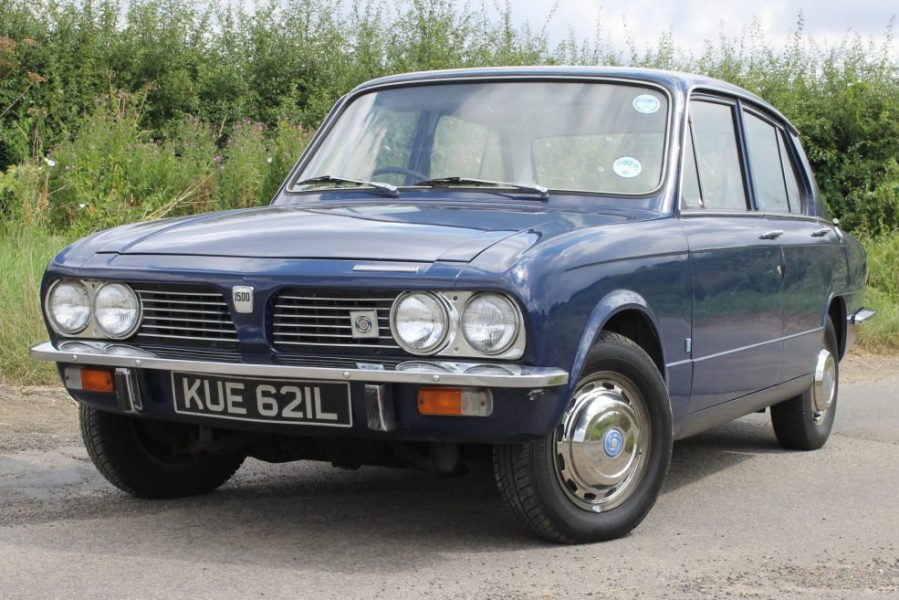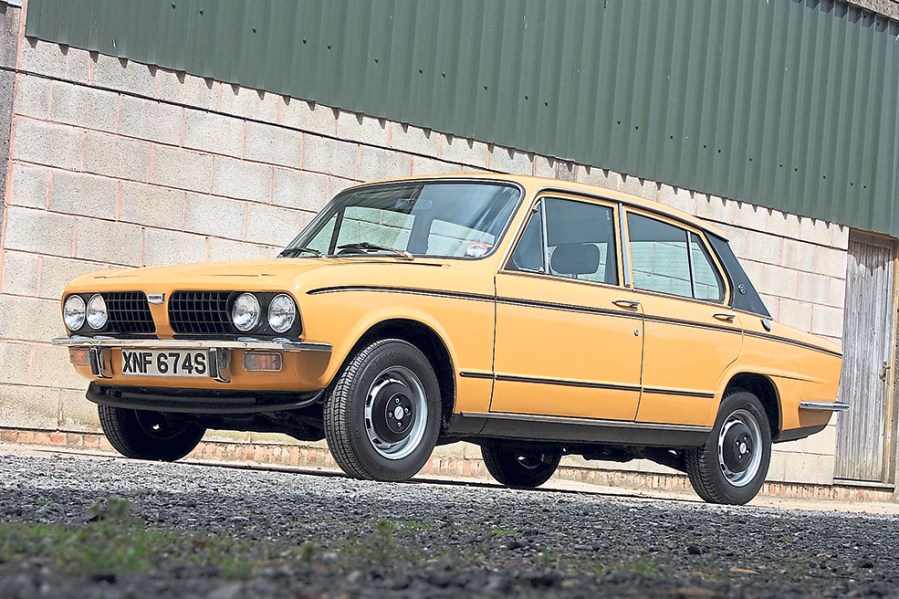For the most part, small Triumph saloons have avoided the stratospheric value rises of some rivals. Here are some of our favourite examples, each a perfect classic all-rounder
Triumph 1300 (1965-1970)
The 1300 began as an intended replacement for the Herald. While the Herald was deliberately old-fashioned so it was simple and cheap to produce in large volumes, Triumph knew that with the arrival of the Mini and the Ford 105E Anglia, standards in the small car market were rising, leaving the somewhat rickety Herald behind.
The replacement would be a combination of the two trendsetters, offering front-wheel drive and fully independent suspension (like the Mini) in a conventional and attractive saloon body (like the Ford). In the end such innovation, including a new transmission and a brand new suspension system with Macpherson struts and trailing arms, proved too expensive to make at the Herald’s price, so the 1300 became a junior partner to the big 2000 saloon and a direct rival to the plusher versions of the BMC 1100 range.
Refined, well-engineered and very modern in its driving manners (and good performance in TC form), the first front-drive Triumph was a great package, let down only by its high cost and Triumph’s limited production capacity. It also proved a hard car to market, with its mix of conventional appearance and advanced specification deterring more people than it attracted.
It would be tempting to say that the 1300 is the ‘forgotten Triumph’, but its long-held status as exactly that has – convolutedly – led to it now becoming increasingly well-known as an unsung gem. Values haven’t changed much though, with prices being pretty much static over the past decade or so.

Triumph 1500 & 1500TC (1970–1976)
The front-wheel drive Triumph didn’t die with the launch of the Toledo; instead, Triumph offered up a higher-end model, with the 1500 featuring the OHV engine in 1493cc guise, sat behind a new front grille with quad lamps. At the other end was a lengthened, squared-off boot matching the style of the facelifted 2000, and under that was a simple dead beam axle. The interior was not as opulent as
the 1300’s, but not as basic as the Toledo’s. The 1500 could be made for less than its predecessor but sold for more – exactly what Triumph wanted. Following the launch of the Dolomite, the inevitable rationalisation took place and the 1500 became the 1500TC in 1973, now with rear-wheel drive and a twin-carb engine. It became the Dolomite 1500 in 1976.
Never big sellers during their brief life, the 1500s survive in small numbers today. This rarity has lifted values in comparison to the Toledo, and they have climbed at a faster rate (20-25 per cent over seven years). The front-wheel drive 1500 seems to fetch only around 10 per cent more over the TC when comparing cars of the same condition. £3000–5000 is the current range for good or very good examples, with cars with some rough edges changing hands for £2000 or a little more.

Triumph Toledo (1970–1976)
In the late 1960s, Triumph needed a new entry-level model to replace both the ageing Herald and the brilliant but overly complicated (and expensive) 1300. The result was the Toledo, which took the 1300’s bodyshell and applied restyled front and rear ends. The 1296cc engine remained, but now driving the rear wheels via a simple coil-sprung live axle instead of the 1300’s independent trailing arms. Inside, the 1300’s elegant interior was swapped for a simplified dashboard made of a single panel of wood and vinyl seats and door trim.
As launched, the Toledo was only available as a two-door with four-wheel drum brakes, although a four-door did arrive later. The equipment list was also gradually improved, acquiring front disc brakes, a heated rear window, stainless steel-trimmed roof gutters, dipping rear-view mirror, reclining front seats and optional brushed nylon trim by the time the Toledo was usurped by the Dolomite 1300 in 1976.
The Toledo is one of those cars that makes an excellent case for itself as a practical, easy to live with classic; it’s survived in surprisingly high numbers, but has so far failed to really catch the interest of the general market, with values rising by about 15 per cent over the past seven years. There are few, if any, seriously threadbare Toledos left, and the decent ones seem to go for £2000–3000, while very tidy ones fetch £4000–5000. Last year we looked at a 1975 example with fewer than 20,000 miles on the clock, entirely original bodywork and a full service history from the supplying dealer, which sold for £14,995 – a truly exceptional example that surely sets the upper limit for values.

Triumph Dolomite (1972–1980)
As we’ve seen, the Dolomite name eventually expanded to offer replacements for the Toledo and 1500TC models. But here we’re only considering the ‘proper’ Dolomite, distinguished by using Triumph’s OHC slant-four engine. Otherwise, it was yet another canny re-use of the small saloon platform, being essentially the 1500 body but with Toledo-sourced rear-wheel drive running gear, tweaked styling to distinguish it from its sisters, and a more upmarket interior to justify its superior pricing.
The standard Dolomite used the 1854cc slant-four, making 91bhp. In 1973 this was joined by the famous Dolomite Sprint, using a 2.0-litre 16-valve version of the engine making 127bhp. Lowered suspension, alloy wheels and a vinyl roof were also part of the Sprint specification. The Sprint was a much-loved car in its time and was regarded as a class leader – an opinion cemented when it won the 1975 BTCC.
Unlike the other two cars here, prices for the Dolomite 1850 seem pretty much static. Auction returns say that £7000-£8000 is the upper limit for well turned-out or restored examples, but occasionally such a car will go for £4000 or so – perhaps suggesting that the numbers still depend on whether there are enough Dolomite fans in the crowd to get the bidding going. Around £4000–5000 is the going rate for a good but ordinary car. But the Sprint is another matter, with the top values doubling over the past five years – although only for the best examples. What was a £7000 car in 2017 would now easily fetch £12,000 or more. Low-mileage Sprints in really good condition can sell for £18,000–20,000 at a high-end dealer.
Triumph Acclaim (1981–1984)
The end of 1500 production marked the close of the front-drive Triumph experiment – but the format reappeared for the ultimate example of the marque in the form of the Acclaim. Of course the Acclaim shared nothing with the older models, or any other Triumph, since it was little more than a re-badged Honda Ballade. That included the 1.3-litre SOHC engine and the five-speed manual and three-speed automatic transmissions, which came straight from Honda.
Despite its lack of family DNA, the Triumph Acclaim was very much in the same mould as its forebears, being a compact, well-appointed, comfortable saloon with decent performance, a balanced ride, good handling and a feel of quality. In the Acclaim’s case the quality was more than skin-deep too, as it immediately proved to be a well-made and reliable car with customer satisfaction and warranty rates at levels that no previous Triumph – or any other British Leyland car – had ever come close to.
Always intended to be a niche product like its predecessors, the Acclaim actually exceeded its sales predictions by some margin even if it was never exactly a fashionable or desirable car – it was too sensible and traditional for the dynamic 1980s. Nonetheless, its success let Triumph go out on something of a high.







